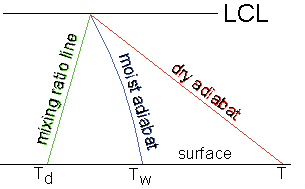
|
E. Linacre and B. Geerts |
7/'98 |
The height at which clouds will form in air that is lifted, for instance over a mountain, is known as the lifting condensation level (LCL). In Note 7.E it was shown that the LCL can be found as the intersection of two lines on an aerological diagram (Note 7.D):
Once the LCL is found, one can easily find the wet-bulb temperature (Tw) at the surface: from the intersection of the two lines mentioned above, follow a saturated adiabat down to ground level and read the temperature (Fig 1). That is the surface wet-bulb temperature. This rule was proposed by C.W.B. Normand in 1924. The reason for this theorem is that the energy consumption that explains the temperature difference between moist and dry adiabats is the same as that that explains the difference between wet and dry bulb thermometer readings.

Fig 1 Illustration of Normand's rule on a simplified skew T log p diagram.